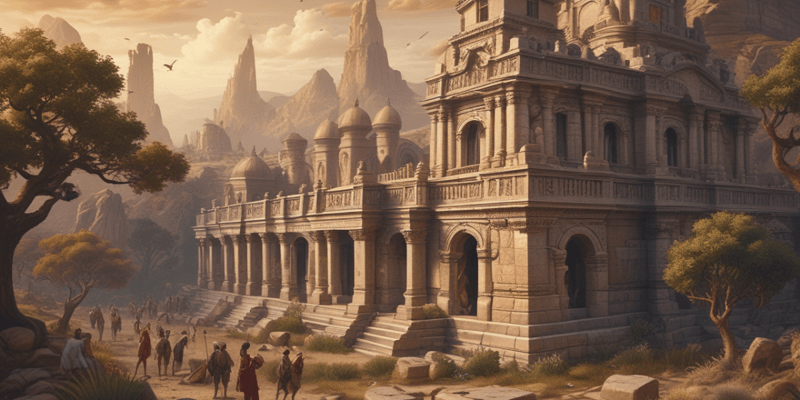Questions and Answers
During which time period did the parchment codex begin to replace wax tablets and papyrus scrolls?
First century
What coincided with the spread of the codex?
The spread of Christianity
What is the Vienna Genesis manuscript a copy of?
A Greek translation of the original Hebrew Bible
What artistic device does the artist use in the Vienna Genesis manuscript?
Signup and view all the answers
What does the Vienna Genesis manuscript combine in its content and style?
Signup and view all the answers
Which type of text did the parchment codex replace in the first or second century?
Signup and view all the answers
What was the purpose of the Vienna Genesis manuscript?
Signup and view all the answers
What type of ink was used in the Vienna Genesis manuscript?
Signup and view all the answers
What is the significance of the bottom half of each page in the Vienna Genesis manuscript?
Signup and view all the answers
What is continuous narration, as used in the Vienna Genesis manuscript?
Signup and view all the answers
What is the Vienna Genesis manuscript primarily about?
Signup and view all the answers
What material was used to write the text in the Vienna Genesis manuscript?
Signup and view all the answers
What is continuous narration, as used in the Vienna Genesis manuscript?
Signup and view all the answers
What is the relationship between the parchment codex and the spread of Christianity?
Signup and view all the answers
Study Notes
Late Antiquity: Art, Architecture, and Manuscripts
- Late Antiquity was a period of diverse societies and cultures in Rome, with significant religious significance.
- Rome became monotheistic in the 4th century, with the emergence of Jewish and Christian art that still had Roman influences.
- Dura-Europos, a distant Roman outpost in Syria, reveals insights into late antiquity and its art, similar to Pompeii.
- The synagogue paintings in Dura-Europos depict biblical themes, surprising scholars as they seemed to defy the second commandment.
- Late Antiquity provides a look into early Christianity, which was still outlawed at the time, but gained official status under Emperor Constantine in 313.
- Early Christian art refers to art with Christian subjects rather than references to Jesus, often found in tombs and catacombs.
- Sculptures in early Christianity favored elaborate marble creations, similar to Roman traditions, and were often found in catacombs.
- Old Saint Peters, built in 319 and sponsored by Constantine, resembled the Basilica Ulpia and the Aula Palatina, accommodating thousands of parishioners.
- Mosaics in churches, such as Santa Maria Maggiore, served as vehicles for instructing the congregation with biblical stories and Christian dogma.
- The Mausoleum of Galla Placidia housed a rich mosaic ensemble, including a notable depiction of Christ as the good shepherd.
- The Church of Santa Sabina exemplifies the essential characteristics of early Christian basilicas, with a dominant central axis and side aisles.
- The Vienna Genesis manuscript, likely made for a wealthy patron in the Byzantine world, gives insight into the use of illustrated codex in early Christianity.
Studying That Suits You
Use AI to generate personalized quizzes and flashcards to suit your learning preferences.
Description
Test your knowledge of the art, architecture, and manuscripts from the period of Late Antiquity, characterized by a fusion of Roman influences and emerging Christian themes. Explore the diverse societies, religious significance, and iconic artworks of this transitional era.




